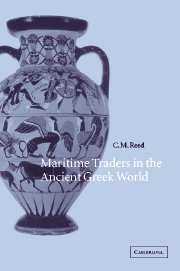Book contents
- Frontmatter
- Contents
- Acknowledgments
- List of abbreviations
- List of references to Greek terms
- Maps
- Introduction
- Chapter 1 Coming to terms
- Chapter 2 Classical modes and patterns of exchange
- Chapter 3 The juridical place of maritime traders
- Chapter 4 The level of wealth of maritime traders
- Chapter 5 Official attitudes towards maritime traders
- Chapter 6 Unofficial attitudes toward maritime traders
- Chapter 7 Archaic modes of exchange and the personnel involved c. 800–475 b.c.
- Chapter 8 Conclusion: then and now
- Appendix 1 Emporoi and nauklēroi: their attested states of origin
- Appendix 2 Cohesion among maritime traders
- Appendix 3 The dikai emporikai
- Appendix 4 Catalogue of emporoi and nauklēroi
- Bibliography
- Index locorum
- General index
Chapter 7 - Archaic modes of exchange and the personnel involved c. 800–475 b.c.
Published online by Cambridge University Press: 22 September 2009
- Frontmatter
- Contents
- Acknowledgments
- List of abbreviations
- List of references to Greek terms
- Maps
- Introduction
- Chapter 1 Coming to terms
- Chapter 2 Classical modes and patterns of exchange
- Chapter 3 The juridical place of maritime traders
- Chapter 4 The level of wealth of maritime traders
- Chapter 5 Official attitudes towards maritime traders
- Chapter 6 Unofficial attitudes toward maritime traders
- Chapter 7 Archaic modes of exchange and the personnel involved c. 800–475 b.c.
- Chapter 8 Conclusion: then and now
- Appendix 1 Emporoi and nauklēroi: their attested states of origin
- Appendix 2 Cohesion among maritime traders
- Appendix 3 The dikai emporikai
- Appendix 4 Catalogue of emporoi and nauklēroi
- Bibliography
- Index locorum
- General index
Summary
INTRODUCTION
In 1983 Paul Cartledge wrote a brief article reaffirming Johannes Hasebroek's basic insights into the place of trade and traders in the world of archaic Greece. Like Hasebroek, Cartledge assumed that, in order to talk sensibly about archaic trade or traders, one had to locate them in a sound socio-economic context. He defended Hasebroek's framework – an overwhelmingly agrarian economy and society, with a ruling class drawing its wealth and prestige from landowning, not commerce, so that the dominance of market relationships or commercial aristocracies were fantasies of those who improperly modernized a world with quite low levels of commercial and manufacturing activity. Cartledge's piece capped a three decade-long effort by substantivist-minded ancient historians, led in Britain by M. I. Finley and G. E. M. de Ste. Croix, to convince their colleagues that this alternate way of looking at Greco-Roman economic activity captured more of the ancient reality.
Were other ancient historians persuaded? Consider recent estimates of archaic market activity. James Redfield speaks of the period 750–700 b.c. as “a time when traders were beginning to transform society …” and concludes that “by the middle of the sixth century this reconstruction was more or less complete…” And Robin Osborne recently wrote, “In this paper I argue that the archaic world was a world of interdependent markets.”
- Type
- Chapter
- Information
- Maritime Traders in the Ancient Greek World , pp. 62 - 74Publisher: Cambridge University PressPrint publication year: 2003



